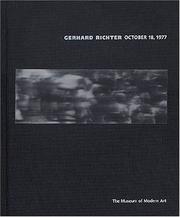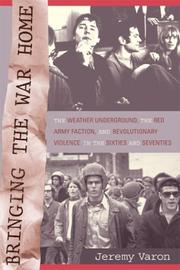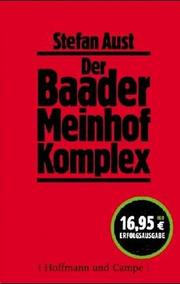| Listing 1 - 10 of 16 | << page >> |
Sort by
|
Book
ISBN: 386521102X Year: 2005 Publisher: Göttingen Steidl
Abstract | Keywords | Export | Availability | Bookmark
 Loading...
Loading...Choose an application
- Reference Manager
- EndNote
- RefWorks (Direct export to RefWorks)
Exhibitions --- Rote Armee Fraktion --- Red Army Faction --- Baader-Meinhof Gang --- Baader-Meinhof Group --- RAF (Red Army Faction) --- Vörös Hadsereg Frakció --- In art --- Press coverage
Book
ISBN: 0586046658 Year: 1978 Publisher: London : Panther, Granada Publ.,
Abstract | Keywords | Export | Availability | Bookmark
 Loading...
Loading...Choose an application
- Reference Manager
- EndNote
- RefWorks (Direct export to RefWorks)
Anarchists --- Terrorism --- Anarchism and anarchists --- Anarchism --- Baader, Andreas, --- Meinhof, Ulrike. --- Meinhof, Ulrike Marie --- Rote Armee Fraktion. --- Red Army Faction --- Baader-Meinhof Gang --- Baader-Meinhof Group --- RAF (Red Army Faction) --- Vörös Hadsereg Frakció --- Criminology. Victimology --- Germany

ISBN: 0870700235 9780870700231 Year: 2000 Publisher: New York: Museum of modern art,
Abstract | Keywords | Export | Availability | Bookmark
 Loading...
Loading...Choose an application
- Reference Manager
- EndNote
- RefWorks (Direct export to RefWorks)
Destined to rank among the most eloquent and thorough examinations of a major suite of paintings, Gerhard Richter: October 18, 1977 combines a lean, persuasively argued text with an elegantly sober design suited to the subject matter. Richter's 15 black-and-white paintings commemorate the day two leaders of the radical German Baader-Meinhof group, disillusioned men and women in their 30s and early 40s whose loyalty to the dogma of the Red Army Faction had led them to commit numerous terrorist acts, were found dead in their prison cells. Gudrun Ensslin appeared to have hung herself. Andreas Baader had been fatally shot. Jan-Carl Raspe was near death from a bullet wound. Two other members of the group had died in prison earlier in the '70s: Holger Meins after a hunger strike; Ulrike Menihof, by hanging. On the Left, there was widespread suspicion the dead had been murdered. Photographs of the Baader-Meinhof members were ubiquitous in newspapers of the day; their images were as familiar to Germans as machine gun-toting Patty "Tania" Hearst was to Americans. Using photographs as models, Richter painted the dead with a subtle technique--a blurring of certain details and an elegiac use of gray--that calls into question the murkiness of historical "knowledge" and emphasizes the uneasy mixture of compassion and horror evoked by the group's fate. Yet, even though Richter waited until 1988 to paint the series, he was denounced either for glorifying a bunch of killers or for using his international fame to exploit the Left. Author Robert Storr, a curator at MoMA, which now owns the series, answers these arguments by looking systematically at postwar German politics, the tradition of history painting, and the dilemmas and decisions of a leading contemporary painter. --(Cathy Curtis).
Richter, Gerhard --- Richter, Gerhard, --- Rote Armee Fraktion --- In art --- Robert Storr --- kunst --- twintigste eeuw --- schilderkunst --- Duitsland --- Richter Gerhard --- Baader-Meinhof --- 75.071 RICHTER --- Rote Armee Fraktion. --- Red Army Faction --- Baader-Meinhof Gang --- Baader-Meinhof Group --- RAF (Red Army Faction) --- Vörös Hadsereg Frakció --- Richter, Gerhard, - 1932- - 18 Oktober 1977 - Exhibitions --- Richter, Gerhard, - 1932- - 18 Oktober 1977

Abstract | Keywords | Export | Availability | Bookmark
 Loading...
Loading...Choose an application
- Reference Manager
- EndNote
- RefWorks (Direct export to RefWorks)
In this first comprehensive comparison of left-wing violence in the United States and West Germany, Jeremy Varon focuses on America's Weather Underground and Germany's Red Army Faction to consider how and why young, middle-class radicals in prosperous democratic societies turned to armed struggle in efforts to overthrow their states. Based on a wealth of primary material, ranging from interviews to FBI reports, this book reconstructs the motivation and ideology of violent organizations active during the 1960s and 1970s. Varon conveys the intense passions of the era--the heat of moral purpose, the depth of Utopian longing, the sense of danger and despair, and the exhilaration over temporary triumphs. Varon's compelling interpretation of the logic and limits of dissent in democratic societies provides striking insights into the role of militancy in contemporary protest movements and has wide implications for the United States' current "war on terrorism." Varon explores Weatherman and RAF's strong similarities and the reasons why radicals in different settings developed a shared set of values, languages, and strategies. Addressing the relationship of historical memory to political action, Varon demonstrates how Germany's fascist past influenced the brutal and escalating nature of the West German conflict in the 60s and 70s, as well as the reasons why left-wing violence dropped sharply in the United States during the 1970s. 'Bringing the War Home' is a fascinating account of why violence develops within social movements, how states can respond to radical dissent and forms of terror, how the rational and irrational can combine in political movements, and finally how moral outrage and militancy can play both constructive and destructive roles in efforts at social change.
Baader-Meinhof gang. --- New Left --- Political violence --- Radicalism --- History --- Weather Underground Organization. --- Weatherman (Organization). --- Baader-Meinhof Gang --- Baader-Meinhof Group --- Baader-Meinhof-Gruppe --- Baader-Meinhofgroep --- Bande à Baader --- Collectif RAF --- FAR --- Fraction Armée rouge --- Groupe Baader-Meinhof --- RAF (Red Army Faction) --- Red Army Faction --- Rote Armee Fraktion --- Germany [West ] --- 20th century --- United States --- Weather Underground Organization
Book
ISBN: 9077941061 Year: 2005 Publisher: Gent Borgerhoff & Lamberigts
Abstract | Keywords | Export | Availability | Bookmark
 Loading...
Loading...Choose an application
- Reference Manager
- EndNote
- RefWorks (Direct export to RefWorks)
Baader-Meinhof Gang --- Baader-Meinhof Group --- Baader-Meinhof-Gruppe --- Baader-Meinhofgroep --- Bande à Baader --- Collectif RAF --- FAR --- Fraction Armée rouge --- Groupe Baader-Meinhof --- RAF (Red Army Faction) --- Red Army Faction --- Terroristen --- Terrorists --- Bin Laden, Osama --- Ku Klux Klan --- Oumu Shinrikyo (religious organization) --- Rote Armee Fraktion --- Carlos
Book
ISBN: 9783506773784 350677378X 3657773789 9783657773787 Year: 2013 Publisher: Paderborn Brill | Schöningh
Abstract | Keywords | Export | Availability | Bookmark
 Loading...
Loading...Choose an application
- Reference Manager
- EndNote
- RefWorks (Direct export to RefWorks)
Die Frage nach dem Mythos RAF und seinen Bestandteilen geistert durch die Terrorismus-Debatten der letzten Jahre, ohne dass genauere Definitionen oder Erklärungen greifbar wären.Welche Mythen zirkulieren über die »Rote Armee Fraktion« und wer hat sie geschaffen? Welche Mythenbestandteile sind heute noch von Bedeutung und welche Bilder der RAF werden dabei vermittelt? Und nicht zuletzt: Welche Bedeutung haben die Wandlungen des Mythos RAF für die bundesrepublikanische Erinnerungskultur? Anhand von Motiven aus Spielfilmen und Romanen zeigt Cordia Baumann nicht nur Ansatzpunkte zur Mythenbildung auf, sondern verfolgt auch die Entwicklung und Veränderung einzelner Mythen um die RAF und ihre Protagonistinnen und Protagonisten.
Terrorism in literature. --- Terrorism in motion pictures. --- Motion pictures --- Rote Armee Fraktion --- Red Army Faction --- Baader-Meinhof Gang --- Baader-Meinhof Group --- RAF (Red Army Faction) --- Vörös Hadsereg Frakció --- In literature. --- In motion pictures. --- allgemeine Literaturwissenschaft --- Filmgeschichte --- Filmkritik --- Filmtheorie --- Literatur --- Literaturwissenschaft

ISBN: 345508253X 9783455082531 Year: 1986 Publisher: Hamburg: Hoffmann und Campe,
Abstract | Keywords | Export | Availability | Bookmark
 Loading...
Loading...Choose an application
- Reference Manager
- EndNote
- RefWorks (Direct export to RefWorks)
International movements --- Germany --- Rote Armee Fraktion --- Baader-Meinhof gang --- -Terrorists --- -#SBIB:321H60 --- Communists --- Terrorists --- #SBIB:321H60 --- #SBIB:324H75 --- #SBIB:343.9H0 --- 323.26 --- 323.26 Actieve politieke strijdmethoden --- Actieve politieke strijdmethoden --- Communism --- Westerse politieke en sociale theorieën vanaf de 19e eeuw: socialisme, marxisme, communisme, anarchisme --- Politieke verandering: revolutie --- Criminologie --- Rote Armee Fraktion. --- Red Army Faction --- Baader-Meinhof Gang --- Baader-Meinhof Group --- RAF (Red Army Faction) --- Vörös Hadsereg Frakció --- Persons --- Communists - Germany (West) --- Terrorists - Germany (West)
Book

ISBN: 9782874158896 Year: 2008 Publisher: Bruxelles Luc Pire
Abstract | Keywords | Export | Availability | Bookmark
 Loading...
Loading...Choose an application
- Reference Manager
- EndNote
- RefWorks (Direct export to RefWorks)
Terroristes --- Terrorisme --- Baader-Meinhof Gang --- Baader-Meinhof Group --- Baader-Meinhof-Gruppe --- Baader-Meinhofgroep --- Bande à Baader --- Collectif RAF --- FAR --- Fraction Armée rouge --- Groupe Baader-Meinhof --- RAF (Red Army Faction) --- Red Army Faction --- Terroristen --- Terrorists --- Sects --- Bin Laden, Osama --- Ku Klux Klan --- Oumu Shinrikyo (religious organization) --- Rote Armee Fraktion --- Carlos --- terroristes célèbres --- terrorisme --- religion --- sectes --- extrémisme politique --- Aum Shinrikyo (オウム真理教) --- Japan --- sarin --- Oussama Ben Laden (1957-2011) --- Fraction Armée Rouge
Book
ISBN: 1281990655 9786611990657 3111735303 3110210827 9783110210828 9783110208108 3110208105 Year: 2008 Publisher: Berlin New York Walter de Gruyter
Abstract | Keywords | Export | Availability | Bookmark
 Loading...
Loading...Choose an application
- Reference Manager
- EndNote
- RefWorks (Direct export to RefWorks)
In der Abhandlung wird der Stil der Texte aus dem Info-System untersucht. Das Info-System diente den inhaftierten Mitgliedern der RAF in den 1970er Jahren dazu, der Haftsituation zum Trotz die Kommunikation untereinander aufrechtzuerhalten. Da die in den Info-Texten verwendete Ausdrucksform als Gruppenstil zu kategorisieren ist, wird im Theorieabschnitt der Untersuchung der Forschungsstand zu diesem Stiltyp referiert, bevor ein systemtheoretischer Ansatz zur Erklärung gruppenstilistischer Phänomene entwickelt wird. Dafür wird die luhmannsche Kommunikationstheorie (sozio-)linguistisch reformuliert, indem die von Luhmann genannten kommunikativen Selektionen mit den sprechakttheoretischen Teilakten ins Verhältnis gesetzt werden. Damit wird es möglich, die Bedeutung von Stil für die Anschlussfähigkeit von Kommunikation systemtheoretisch zu erklären. Im Analyseabschnitt werden unter Berücksichtigung der verwendeten Textsorten und mit Hilfe eines über- und intertextuellen Vergleichsverfahrens die Stilelemente ermittelt, die sich zum Gruppenstil der RAF im Info-System synthetisieren. Auf Grundlage der detaillierten Beschreibung der Stilstruktur werden Sinnzuschreibungen formuliert, die u.a. die revolutionäre Sprachgewalt der RAF thematisieren.
Sociolinguistics. --- Language and languages. --- Written communication. --- Written discourse --- Written language --- Communication --- Discourse analysis --- Language and languages --- Visual communication --- Foreign languages --- Languages --- Anthropology --- Ethnology --- Information theory --- Meaning (Psychology) --- Philology --- Linguistics --- Language and society --- Society and language --- Sociology of language --- Language and culture --- Sociology --- Integrational linguistics (Oxford school) --- Social aspects --- Sociological aspects --- Rote Armee Fraktion. --- Red Army Faction --- Baader-Meinhof Gang --- Baader-Meinhof Group --- RAF (Red Army Faction) --- Vörös Hadsereg Frakció --- Army Faction (RAF). --- Communication. --- Group Style. --- System Theory.
Book
ISBN: 9781139549615 1139549618 9781139552110 1139552112 1283574942 9781283574945 9781139084123 1139084127 9781139554572 1139554573 9781107017375 1107017378 1139564420 9781139564427 1139887513 9781139887519 1139550861 9781139550864 9786613887399 6613887390 1139555820 9781139555821 9781107429451 1107429455 Year: 2012 Publisher: Cambridge Cambridge University Press
Abstract | Keywords | Export | Availability | Bookmark
 Loading...
Loading...Choose an application
- Reference Manager
- EndNote
- RefWorks (Direct export to RefWorks)
In 1970, the Red Army Faction declared war on West Germany. The militants failed to bring down the state, but this book argues that the decade-long debate they inspired helped shape a new era. After 1945, West Germans answered long-standing doubts about democracy's viability and fears of authoritarian state power with a 'militant democracy' empowered against its enemies and a popular commitment to anti-fascist resistance. In the 1970s, these postwar solutions brought Germans into open conflict, fighting to protect democracy from both terrorism and state overreaction. Drawing on diverse sources, Karrin Hanshew shows how Germans, faced with a state of emergency and haunted by their own history, managed to learn from the past and defuse this adversarial dynamic. This negotiation of terror helped them to accept the Federal Republic of Germany as a stable, reformable polity and to reconceive of democracy's defence as part of everyday politics.
Terrorism --- Democracy --- Acts of terrorism --- Attacks, Terrorist --- Global terrorism --- International terrorism --- Political terrorism --- Terror attacks --- Terrorist acts --- Terrorist attacks --- World terrorism --- Direct action --- Insurgency --- Political crimes and offenses --- Subversive activities --- Political violence --- Terror --- Self-government --- Political science --- Equality --- Representative government and representation --- Republics --- History. --- Rote Armee Fraktion --- Red Army Faction --- Baader-Meinhof Gang --- Baader-Meinhof Group --- RAF (Red Army Faction) --- Vörös Hadsereg Frakció --- Germany (West) --- Politics and government --- Arts and Humanities --- History
| Listing 1 - 10 of 16 | << page >> |
Sort by
|

 Search
Search Feedback
Feedback About UniCat
About UniCat  Help
Help News
News